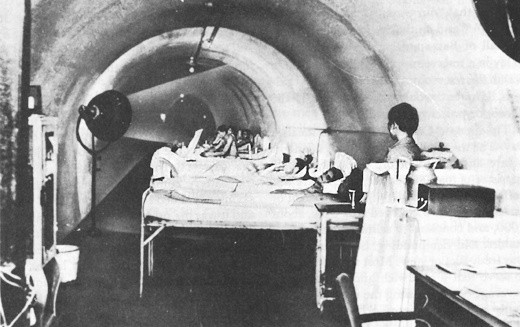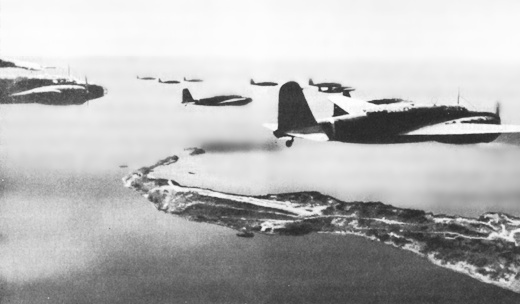Sarah Sundin's Blog, page 134
May 8, 2022
Today in World War II History—May 8, 1942

USS Lexington’s crewmen abandoning ship to a destroyer, 8 May 1942 (US Naval History & Heritage Command: 80-G-7398)
80 Years Ago—May 8, 1942: Battle of the Coral Sea concludes: US deters Japanese landing at Port Moresby, New Guinea, the first time in the war that the Japanese navy fails to achieve an objective.
In Battle of the Coral Sea, carrier USS Lexington is badly damaged and scuttled.
Japanese take Myitkyina, the last viable airfield to supply China from Burma.
Alvin York, WWI Medal of Honor recipient “Sergeant York,” is commissioned as a major.
The post Today in World War II History—May 8, 1942 first appeared on Sarah Sundin.May 7, 2022
Today in World War II History—May 7, 1942

Japanese carrier Shoho under attack by US Navy TBD-1 torpedo bomber, 7 May 1942 (US National Archives: 80-G-17015)
80 Years Ago—May 7, 1942: In the Battle of the Coral Sea, destroyer USS Sims and Japanese small carrier Shoho are sunk.
Japanese execute José Abad Santos, chief justice of the Philippines, for refusing to participate in the puppet government.
The post Today in World War II History—May 7, 1942 first appeared on Sarah Sundin.May 6, 2022
Today in World War II History—May 6, 1942

Surrender of American troops at Corregidor, Philippine Islands, 6 May 1942 (US National Archives: 535523)
80 Years Ago—May 6, 1942: US Maj. Gen. Jonathan Wainwright surrenders on Corregidor, the unconditional surrender of all US and Filipino troops in the Philippines, 13,000 POWs.
US Gen. Joseph Stilwell sets off on foot from Burma toward India with 100 military personnel and civilians.
US Army Air Force impresses all but 200 civilian DC-3s into military service, to be converted to C-47 Skytrain cargo planes.
First American Red Cross Service Club opens in the United Kingdom, at Northern Counties Hotel in Londonderry, Northern Ireland.

Douglas C-47 Skytrain of US Air Transport Command, 1940s (US Air Force photo)
The post Today in World War II History—May 6, 1942 first appeared on Sarah Sundin.May 5, 2022
Today in World War II History—May 5, 1942

Navajo code-talkers on Bougainville, December 1943 (US Marine Corps photo)
80 Years Ago—May 5, 1942: Japanese land on Corregidor in the Philippines.
British land at Diego Suarez in Vichy-French Madagascar, fearing Japanese takeover and control of the Indian Ocean.
First 29 Navajo recruits begin boot camp with the US Marine Corps; they will pioneer code-talking.
Sugar rationing begins in the United States (Read more: “Make It Do—Sugar Rationing in World War II.”)

Fulmar fighters aboard carrier HMS Formidable off Madagascar, early May 1942 (Imperial War Museum: A 9710)
The post Today in World War II History—May 5, 1942 first appeared on Sarah Sundin.May 4, 2022
Today in World War II History—May 4, 1942

SBD Dauntless returning to USS Yorktown after an attack on Tulagi, Solomon Islands, 4 May 1942 (US National Archives: 80-G-20515)
80 Years Ago—May 4, 1942: Battle of the Coral Sea begins: US Navy intercepts Japanese fleet set to invade Port Moresby, New Guinea: first carrier vs. carrier battle in history and the first battle where enemy ships never see each other.
Off the Florida Keys, German U-boat U-507 sinks US freighter Norlindo, the first sinking in the Gulf of Mexico.
Vilhelm Buhl becomes Prime Minister of (Nazi-occupied) Denmark.
The post Today in World War II History—May 4, 1942 first appeared on Sarah Sundin.May 3, 2022
Today in World War II History—May 3, 1942

Hospital in Malinta Tunnel, Corregidor, 1942 (US Army Center of Military History)
80 Years Ago—May 3, 1942: In Solomon Islands, Japanese take Tulagi and Florida Islands, adjacent to Guadalcanal.
Sub USS Spearfish evacuates 27 personnel from Corregidor, including nurses, the last evacuation by sub from Luzon.
Prime Minister of (Nazi-occupied) Denmark Thorvald Stauning dies in Copenhagen, age 68.
The post Today in World War II History—May 3, 1942 first appeared on Sarah Sundin.May 2, 2022
Make It Do – Sugar Rationing in World War II

What could be more American than Hershey bars, homemade cookies, and birthday cake? During World War II, these items were hard to come by in the United States.
Short on Sugar
US poster, WWII
When the Japanese conquered the Philippines in the early months of 1942, the United States lost a major source of sugar imports. Shipments from Hawaii and Central and South America had to be curtailed 50 percent as cargo vessels were diverted for military purposes – and due to heavy losses of cargo ships to German U-boats in early 1942. The supply of sugar fell by one-third. To ensure adequate supplies for manufacturers, the military, and civilians, sugar became the first food item to be rationed. Manufacturers initially received supplies at 80 percent of pre-war levels, but that was reduced over time.
Registration for Rationing
US poster about food rationing, 1943 (US Office of Price Administration)
On April 27, 1942, families registered for ration books at their local elementary schools. One book was issued for each family member and had to be surrendered upon death. The sale of sugar was halted for one week to prepare for the program. To discourage hoarding, each family had to report how much sugar they had in stock over a certain amount – and the corresponding number of stamps was removed from the book. To further prevent hoarding, the sale of sugar was halted for a week.
Ration Books
US rationing books owned by my mother and grandmother, WWII (Photo: Sarah Sundin)
On May 5, 1942, each person in the United States received a copy of War Ration Book One, good for a 56-week supply of sugar. Initially, each stamp was good for one pound of sugar and could be used over a specified two-week period. On June 28, 1942, each stamp became good for two pounds of sugar over a four-week period. The ration book bore the recipient’s name and could only be used by household members. Stamps had to be torn off in the presence of the grocer.
If the book was lost, stolen, or destroyed, an application had to be submitted to the Ration Board for a new copy. When entering the hospital for greater than ten days, the ration book had to be brought along.
On September 12, 1943, War Ration Book Three became active, replacing both Book One (sugar & coffee) and Book Two (meats, cheeses, canned & processed foods, and butter & cooking oil). War Ration Book Four replaced Book Three on November 1, 1944.
Canning
US poster promoting canning, 1943
Home canning was encouraged during the war to reduce the use of rationed canned fruits and vegetables – however, canning requires sugar. To provide for this patriotic need, each person could apply for a 25-pound allotment of canning sugar each year. Each local ration board determined the quantity and season of availability based on the local harvest. A special canning sugar stamp in the ration book had to be attached to the application. In 1944, confusion arose when “spare canning sugar stamp 37” was called for – but many people mistakenly used the regular sugar stamp 37, invalidating it for normal household purchases.
Sugar Shortages
Knox Wartime Recipes: How to be Easy on Your Ration Book, 1943 (Smithsonian)
Just because you had a sugar stamp didn’t mean sugar was available for purchase. Shortages occurred often during the war, and in early 1945 became acute. As Europe was liberated from Nazi Germany, the US took on the main responsibility for providing food to those ravaged countries. On May 1, 1945, the sugar ration was cut to 15 pounds per year for household use and 15 pounds per year for canning – a total of eight ounces per week.
Sugar was the last product to remain on rationing after the war. The program was discontinued in June 1947.
Housewives learned to be creative, using saccharine, corn syrup, and even packets of flavored gelatin as sugar substitutes. Women’s magazines featured recipes with reduced sugar or creative substitutes.
Do you have any stories of wartime sugar rationing?
The post Make It Do – Sugar Rationing in World War II first appeared on Sarah Sundin.Today in World War II History—May 2, 1942

Japanese bombers over Corregidor, 1942 (US Army Center of Military History)
80 Years Ago—May 2, 1942: Japanese bomb powder magazine on Corregidor, 60 Americans killed.
In Allied Arctic Convoy QP-11 returning from USSR, German destroyer Z-24 damages British light cruiser Edinburgh, carrying £5 million in Soviet gold; the cruiser is scuttled.
The post Today in World War II History—May 2, 1942 first appeared on Sarah Sundin.May 1, 2022
Today in World War II History—May 1, 1942

US poster encouraging purchase of War Stamps, WWII
80 Years Ago—May 1, 1942: In Burma, Japanese take Mandalay and Monywa.
US starts War Stamp drive, through May 31, run through drugstores and other retail stores. (Read more: “World War II War Bonds”)
The post Today in World War II History—May 1, 1942 first appeared on Sarah Sundin.April 30, 2022
Today in World War II History—April 30, 1942

Bell P-39Q Airacobra, 1940s (USAAF photo)
80 Years Ago—Apr. 30, 1942: First use of US Bell P-39 Airacobra fighter plane in combat—Australia-based P-39s fly mission to Lae and Salamaua, New Guinea.
USS Peto, the first sub built on the Great Lakes, is launched at Manitowoc, WI.
Japanese secure central Burma.

USS Peto side launching at Manitowoc Shipbuilding Co, Manitowoc, WI, 30 April 1942 (US Navy photo).
The post Today in World War II History—April 30, 1942 first appeared on Sarah Sundin.


